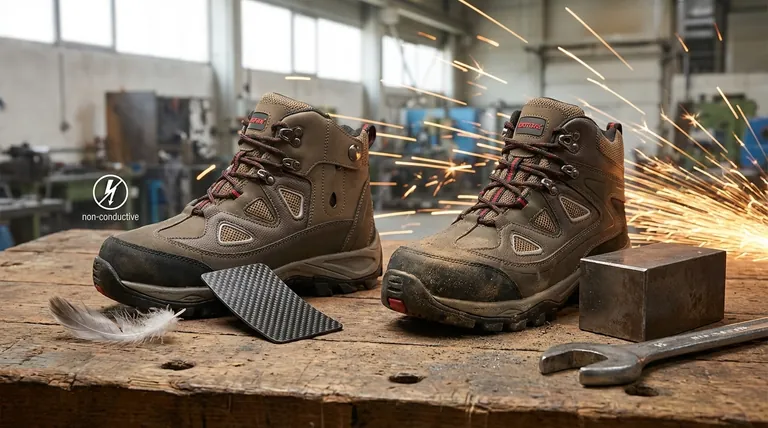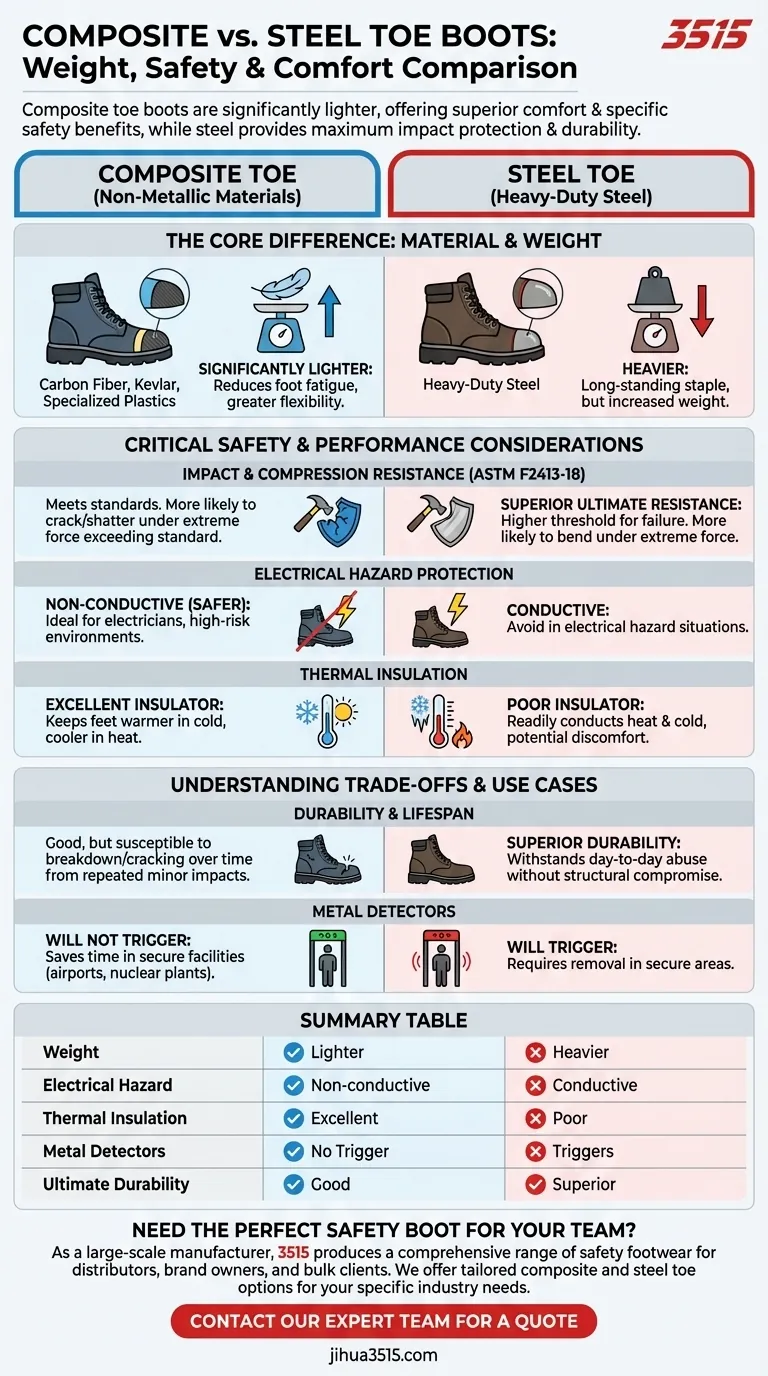In a direct comparison, composite toe boots are significantly lighter than steel toe boots. This weight reduction is a primary design feature, achieved by using non-metallic materials like carbon fiber, Kevlar, or specialized plastics for the protective cap instead of traditional steel. While both are engineered to meet the same foundational safety standards, the difference in material creates critical trade-offs in performance and application.
The core decision between composite and steel toes is not about which is universally "better," but which is correct for your specific environment. Steel offers the highest level of impact and compression resistance, while composite provides superior comfort, thermal insulation, and essential non-conductive properties for specialized work.

The Core Difference: Material and Weight
The fundamental distinction between these two types of safety footwear lies in the material used for the protective toe cap. This single choice directly influences weight, conductivity, and comfort.
How Steel Toes Achieve Protection
A steel toe boot uses a cap made of heavy-duty steel. This material provides exceptional resistance to impact and compression, making it a long-standing staple in heavy industrial and construction environments. The trade-off for this high level of protection is its significant weight and its tendency to conduct temperature.
How Composite Toes Achieve Protection
Composite toe caps are made from a blend of non-metallic materials. These can include carbon fiber, high-strength plastics, and Kevlar fibers. This advanced construction allows them to meet safety standards while being considerably lighter than steel.
The Tangible Impact of Lighter Weight
The reduced weight of composite toe boots directly translates to less foot fatigue over a long workday. Many users also find them more flexible, allowing for a more natural and comfortable range of motion.
Beyond Weight: Critical Safety Considerations
While weight is a key factor for comfort, the primary purpose of a safety boot is protection. Here, the material differences become even more critical.
Impact and Compression Resistance
Both steel and composite toe boots are required to meet the same ASTM F2413-18 standards for impact and compression. However, steel has a higher threshold for ultimate failure. Under an extreme impact or compression force that exceeds the standard, a composite toe is more likely to crack or shatter, while steel is more likely to bend.
Electrical Hazard Protection
This is a non-negotiable distinction. Because they are made of non-metallic materials, composite toes do not conduct electricity. This makes them the only appropriate choice for electricians or anyone working in an environment with a high risk of electrical hazards. Steel is a conductor and should be avoided in these situations.
Thermal Insulation
Steel readily conducts both heat and cold, which can lead to significant discomfort in extreme temperature environments. Composite materials are far superior insulators, helping to keep your feet warmer in the cold and cooler in the heat.
Understanding the Trade-offs
Choosing the right boot means acknowledging the inherent compromises of each design. There is no single perfect solution for every job.
Durability and Lifespan
Steel is an exceptionally durable material. Steel toe caps can withstand a great deal of day-to-day abuse without compromising their structural integrity. Composite materials, while strong, can be more susceptible to breaking down or cracking over time, especially after repeated minor impacts.
Environments with Metal Detectors
For professionals working in secure facilities like airports, nuclear plants, or government buildings, composite toes offer a clear advantage. Their non-metallic construction means they will not trigger metal detectors, saving significant time and hassle.
Making the Right Choice for Your Work Environment
Your specific job site and daily tasks should be the ultimate guide in your decision.
- If your primary focus is maximum impact and compression protection in heavy construction, manufacturing, or logging: Choose steel for its superior strength and durability.
- If your primary focus is electrical hazard safety or you frequently pass through metal detectors: Composite is the necessary and correct choice.
- If your primary focus is all-day comfort, reduced fatigue, and protection in extreme temperatures for moderate-risk roles like warehouse work or general contracting: Composite offers the ideal balance of safety and comfort.
Ultimately, understanding the distinct properties of each material empowers you to select the right tool for the job.
Summary Table:
| Feature | Composite Toe Boots | Steel Toe Boots |
|---|---|---|
| Weight | Lighter | Heavier |
| Electrical Hazard | Non-conductive (Safer) | Conductive |
| Thermal Insulation | Excellent | Poor (conducts temperature) |
| Metal Detectors | Will not trigger | Will trigger |
| Ultimate Durability | Good | Superior |
Need the Perfect Safety Boot for Your Team?
As a large-scale manufacturer, 3515 produces a comprehensive range of footwear for distributors, brand owners, and bulk clients. Our production capabilities encompass all types of safety shoes and boots, including both composite and steel toe options tailored to your specific industry needs.
We can help you provide your workforce with the ideal balance of lightweight comfort, essential safety, and long-lasting durability.
Contact our expert team today to discuss your requirements and request a quote.
Visual Guide

Related Products
- Safety Footwear Wholesale Manufacturer for Custom OEM/ODM Production
- Premium KPU Injection Athletic Style Safety Shoes
- Wholesale Safety Footwear Manufacturer for Bulk & Custom OEM Orders
- Wholesale Customizable Safety Boots Durable & Protective Footwear Manufacturing
- Premium Flame-Retardant Waterproof Safety Boots and Shoes
People Also Ask
- How do safety shoes contribute to cost savings for companies? A Strategic Investment in Risk and Cost Management
- What are OSHA approved shoes? Understanding the Correct Standards for Workplace Safety
- Do snake bite boots work? Your Ultimate Guide to Effective Snake Bite Protection
- How long can you wear safety boots? The Lifespan is Determined by Wear, Not Time
- What are the differences between steel toe, composite toe, and alloy toe Wellington boots? Choose the Right Safety Toe for Your Job



















